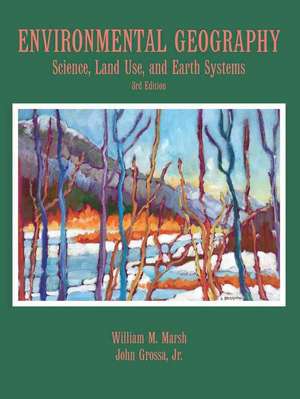Environmental Geography: Science, Land Use, and Earth Systems
Autor William M. Marsh, John Grossaen Limba Engleză Hardback – 6 dec 2004
Preț: 638.23 lei
Preț vechi: 839.78 lei
-24% Nou
Puncte Express: 957
Preț estimativ în valută:
122.16€ • 132.74$ • 102.68£
122.16€ • 132.74$ • 102.68£
Carte tipărită la comandă
Livrare economică 18-29 aprilie
Preluare comenzi: 021 569.72.76
Specificații
ISBN-13: 9780471482802
ISBN-10: 0471482803
Pagini: 512
Dimensiuni: 222 x 280 x 24 mm
Greutate: 1.21 kg
Ediția:Revised
Editura: JOHN WILEY & SONS INC
Locul publicării:Hoboken, United States
ISBN-10: 0471482803
Pagini: 512
Dimensiuni: 222 x 280 x 24 mm
Greutate: 1.21 kg
Ediția:Revised
Editura: JOHN WILEY & SONS INC
Locul publicării:Hoboken, United States
Public țintă
Geographers, Environmentalists, Geography students.Descriere
An environmental studies text written for geographers by geographersOffering a true geographic approach to environmental issues, this Third Edition of William Marsh and John Grossa’s ENVIRONMENTAL GEOGRAPHY: SCIENCE, LAND USE, AND EARTH SYSTEMS examines human–related environmental issues in the context of the processes and systems of physical geography.
Throughout, the authors emphasize traditional themes of geography, such as the concept of an integrated planet; the principles of space, scale, and distributions; the idea of landscape as a human–environmental interplay; and the perspective of earth as a dynamic planet with many environmental opportunities, constraints, and risks.
Now updated and revised, this Third Edition features:
Throughout, the authors emphasize traditional themes of geography, such as the concept of an integrated planet; the principles of space, scale, and distributions; the idea of landscape as a human–environmental interplay; and the perspective of earth as a dynamic planet with many environmental opportunities, constraints, and risks.
Now updated and revised, this Third Edition features:
- A continuing theme of sustainability, with more emphasis on efforts by governments, corporations, private organizations, and individuals that are showing promise in bringing us into balance with the planet.
- 16 new case studies, 12 of which deal with sustainability issues.
- A revised organization. The first five chapters have been rearranged to provide a better flow of topics from issues and perspectives, to environmental foundation material, to factual matter on the condition of earth and its people.
- New material in several chapters, including the increasing role of NGO′s in working out solutions to environmental problems from the global to the local level.
- Thoroughly updated statistics on population, energy, and food production.
- Revised graphics, including dozens of new photos.
Textul de pe ultima copertă
An environmental studies text written for geographers by geographersOffering a true geographic approach to environmental issues, this Third Edition of William Marsh and John Grossa’s ENVIRONMENTAL GEOGRAPHY: SCIENCE, LAND USE, AND EARTH SYSTEMS examines human–related environmental issues in the context of the processes and systems of physical geography.
Throughout, the authors emphasize traditional themes of geography, such as the concept of an integrated planet; the principles of space, scale, and distributions; the idea of landscape as a human–environmental interplay; and the perspective of earth as a dynamic planet with many environmental opportunities, constraints, and risks.
Now updated and revised, this Third Edition features:
Throughout, the authors emphasize traditional themes of geography, such as the concept of an integrated planet; the principles of space, scale, and distributions; the idea of landscape as a human–environmental interplay; and the perspective of earth as a dynamic planet with many environmental opportunities, constraints, and risks.
Now updated and revised, this Third Edition features:
- A continuing theme of sustainability, with more emphasis on efforts by governments, corporations, private organizations, and individuals that are showing promise in bringing us into balance with the planet.
- 16 new case studies, 12 of which deal with sustainability issues.
- A revised organization. The first five chapters have been rearranged to provide a better flow of topics from issues and perspectives, to environmental foundation material, to factual matter on the condition of earth and its people.
- New material in several chapters, including the increasing role of NGO′s in working out solutions to environmental problems from the global to the local level.
- Thoroughly updated statistics on population, energy, and food production.
- Revised graphics, including dozens of new photos.
Cuprins
Chapter 1: A World in Crisis: Environment and Humanity in the 21st Century
Chapter 2: Preparing to Understand Environmental Geography
Chapter 3: Environment, Land Use and Sustainable Development
Chapter 4: The Spread and Development of Human Population
Chapter 5: Global Cycles and Systems
Chapter 6: Ecosystems and the Bioclimatic Environment
Chapter 7: The Human Population: Trends and Patterns
Chapter 8: Agriculture, Food Production and Hunger
Chapter 9: Energy Generation, Use, and the Environment
Chapter 10: Atmospheric Environment and Land Use
Chapter 11: Air Population: Patterns, Trends and Impacts
Chapter 12: Hydrologic Environment and Land Use
Chapter 13: Water Pollution: Patterns, Trends and Impacts
Chapter 14: Hazardous Waste Production and Disposal
Chapter 15: Soil, Land and Land Use
Chapter 16: Biological Diversity and Land Use
Chapter 17: Open–Land Resources: Forests, Rangelands, Parks and Preserves
Chapter 18: Managing the Global Environment
Appendices
Glossary
Index
Chapter 2: Preparing to Understand Environmental Geography
Chapter 3: Environment, Land Use and Sustainable Development
Chapter 4: The Spread and Development of Human Population
Chapter 5: Global Cycles and Systems
Chapter 6: Ecosystems and the Bioclimatic Environment
Chapter 7: The Human Population: Trends and Patterns
Chapter 8: Agriculture, Food Production and Hunger
Chapter 9: Energy Generation, Use, and the Environment
Chapter 10: Atmospheric Environment and Land Use
Chapter 11: Air Population: Patterns, Trends and Impacts
Chapter 12: Hydrologic Environment and Land Use
Chapter 13: Water Pollution: Patterns, Trends and Impacts
Chapter 14: Hazardous Waste Production and Disposal
Chapter 15: Soil, Land and Land Use
Chapter 16: Biological Diversity and Land Use
Chapter 17: Open–Land Resources: Forests, Rangelands, Parks and Preserves
Chapter 18: Managing the Global Environment
Appendices
Glossary
Index
